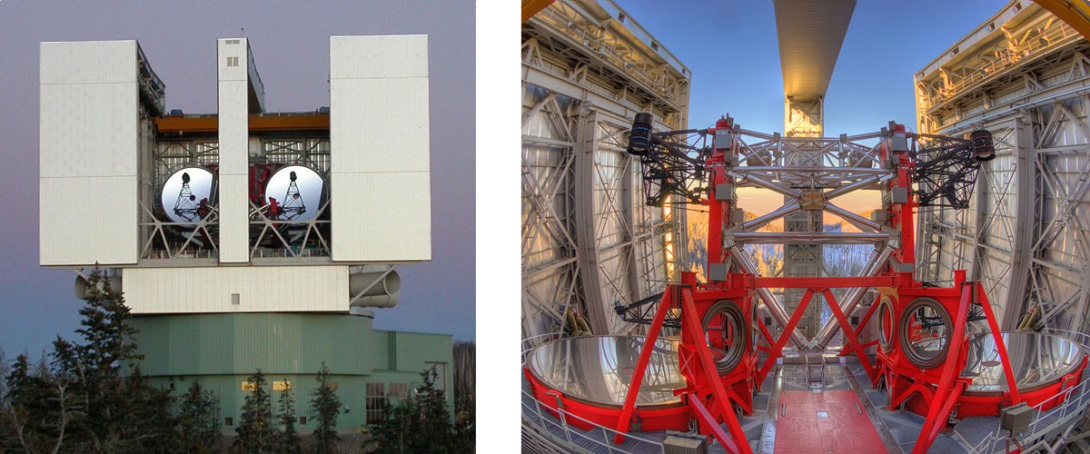ECMWF products help the ALTA Center in Italy to forecast optical turbulence in order to support astronomical ground-based observations of the Large Binocular Telescope (LBT) in Arizona, USA.
The impact of turbulence
Turbulence in the Earth’s atmosphere strongly limits the resolution of ground-based astronomy in visible and infrared wavelengths. Resolution measures the ability to detect the smallest details of images taken in the focal point of an optical system. Telescope resolution is, in theory, inversely proportional to telescope diameter size: the larger the telescope diameter, the higher the resolution. In reality, because of the presence of atmospheric turbulence, ground-based top-class telescopes (8–10 m in diameter) cannot achieve their potential intrinsic resolution unaided. Such turbulence is called ‘optical turbulence’. It is triggered by fluctuations in temperature that determine fluctuations in the refractive index of the atmosphere. This in turn influences the amplitude and phase of wavefronts that interact with the atmosphere. When light wavefronts pass through the atmosphere, they are not any more perfectly plane, as they are when they travel in empty space. Consequently, observed point sources (for example stars) are revealed on the ground-based telescope detector as spots in which the light intensity is spread over a set of large, blurred surfaces instead of being concentrated in individual points.
Adaptive Optics (AO) techniques exist today to correct wavefront perturbations induced by optical turbulence, but AO performance strongly depends on turbulence conditions. It is therefore mandatory to know turbulence conditions in advance to optimise the use of telescopes. It is indeed known, for example, that the most challenging scientific programmes frequently require the weakest turbulence conditions. When turbulence conditions are less favourable, it might be more efficient to perform scientific astronomical programmes that do not require the best resolution. Knowing turbulence conditions in advance thus leads to an efficient use of these complex facilities. This is important to achieve the most relevant progress in our knowledge of the universe. The cost of a night of observation for a telescope of the present generation is in the order of one hundred thousand dollars. It is therefore crucial to optimise the exploitation of these facilities, and in particular to allocate observation time for scientific projects in the presence of suitable turbulence conditions that can guarantee the best outputs.

The role of ECMWF’s forecasts
The ALTA Center (alta.arcetri.inaf.it and https://www.lbto.org/weather-forecast/) is an automatic forecasting system that was conceived and developed in 2015 to provide nightly forecasts of optical turbulence and atmospheric parameters relevant for ground-based astronomy to support the science operations of the LBT (see the two photos). The forecasting system is based on a mesoscale model (Meso-NH – mesoscale-non-hydrostatic, developed by the CNRM-Météo-France/Laboratoire d’Aerologie, Toulouse, France) and code expressly conceived for optical turbulence (Astro-Meso-NH, see Masciadri et al., 1999, A&AS, 137, 185). Since 2016, the ALTA Center has been supporting astronomical observations at the LBT. To set up the ALTA Center, the Astro-Meso-NH package has been transformed into an automatic forecasting system that is fed with initialisation and forcing data coming from ECMWF. Starting from the optical turbulence vertical distribution over the whole atmosphere, a set of further astroclimatic parameters, such as the wavefront coherence time, the isoplanatic angle and the ground layer fraction, which are useful to characterise AO performance, are retrieved, too. The ALTA Center provides forecasts at long time scales (in the afternoon for the coming night) and at short time scales (time scales of few hours, typically one or two hours). The latter are the most critical for the ‘flexible scheduling’ of observations, i.e. the scheduling of observational programmes depending on turbulence conditions. The first plot in the second figure shows the temporal evolution of 'astronomical seeing', which is a measure of the degradation of the image of an astronomical object due to turbulence in the atmosphere. It shows forecasts on short timescales and on a long timescale as well as observations. The second plot shows ALTA Center performances in forecasting the optical turbulence on a timescale of one hour calculated on a sample of one solar year.

A new Adaptive Optics system
The LBT is made up of two 8.4‑metre telescopes mounted on the same structure. When it works in interferometric mode, its diameter reaches the equivalent value of 22.4, delivering the sharpest images ever obtained in the visible and infrared regimes by a single telescope. The LBT can therefore be considered the precursor of the new generation of Extremely Large Telescopes (ELTs) (30–40 m) and, at present, is the ground-based telescope with the largest equivalent diameter size in the world. The ALTA Center supports science operations of observations performed with present, forthcoming, and future astronomical instruments of LBT. In recent years, the LBT Observatory has invested in a new AO system called SOUL (Pinna et al., 2021, DOI:10.48550/ arXiv.2101.07091). This makes it possible to strongly improve image resolution and to discern many more point sources that would not be visible otherwise. It also means we can go deeper into the Universe. The last figure shows the image of a massive young stellar object with its outflow as observed without any AO system and with the AO system SOUL. New high-contrast imaging instruments (SHARK-NIR and SHARK-VIS), using SOUL, will see the light in the forthcoming two years. Using initialisation and forcing data from ECMWF, the ALTA Center will be able to play a crucial role in identifying the best atmospheric conditions to carry out the most challenging astrophysical observations.


